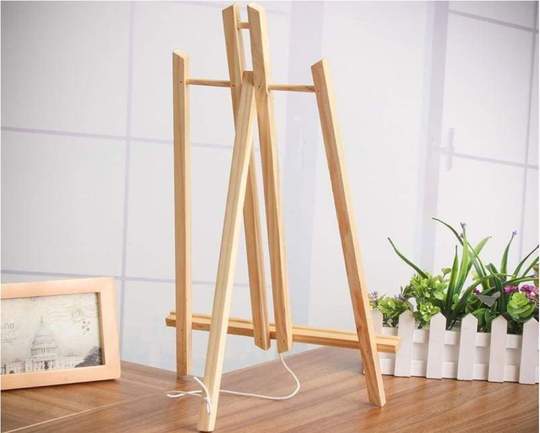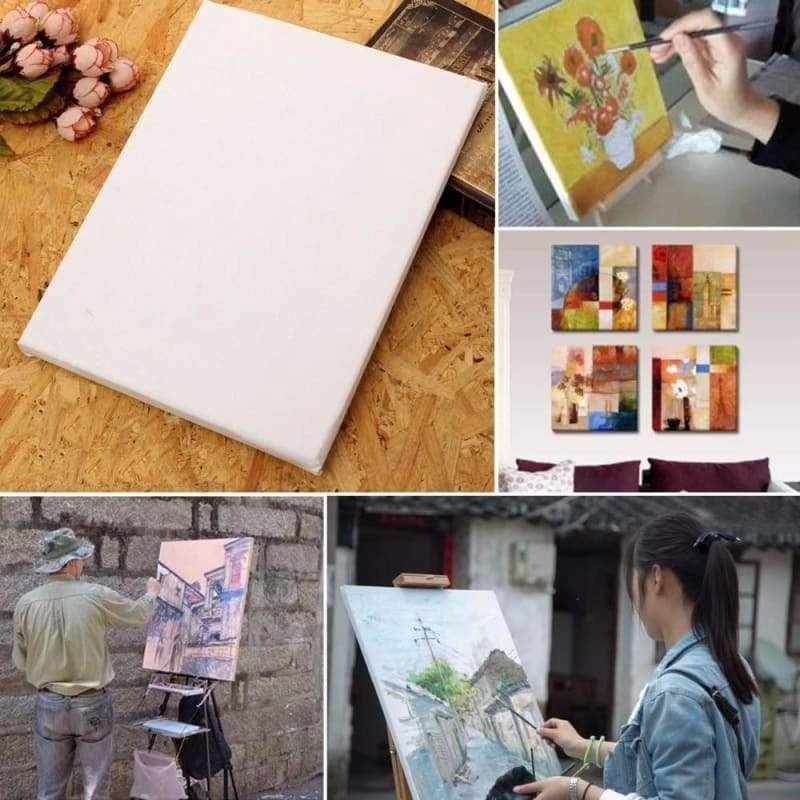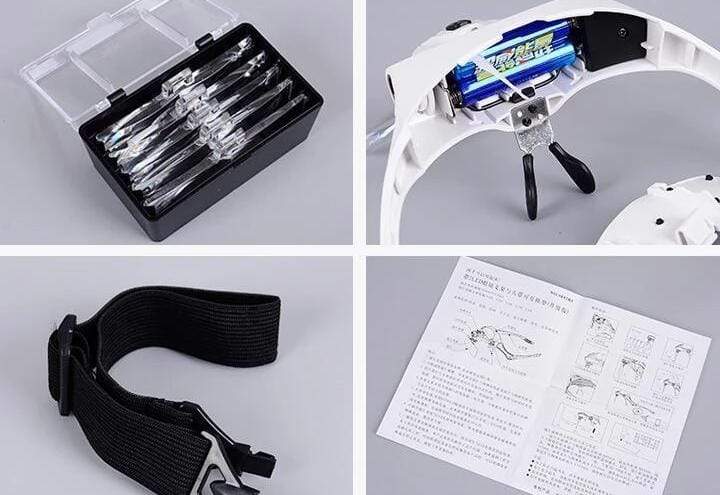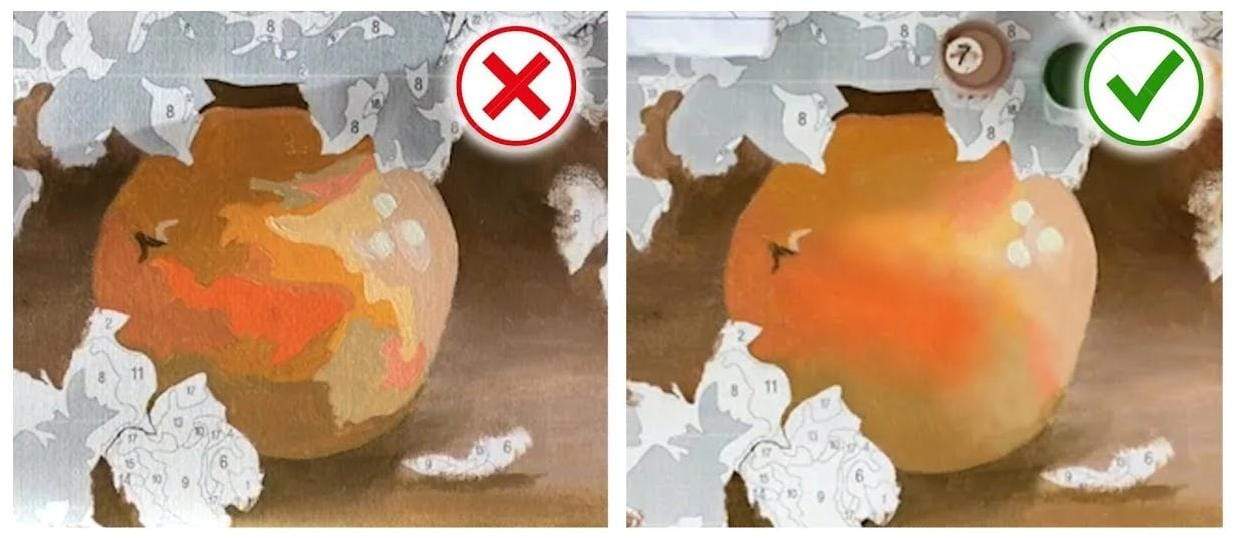These are the 10 tips that will help you create your work. These tips are mainly meant for the more experienced artists/clients, who have already painted at least one canvas. But, you can also take these tips with you from the beginning if you want!
10. How do you make sure the numbers don't remain visible through the paint?

Professional white brushes for your paint by numbers.
Often you can't see the numbers through the paint, but it can happen with light colors. The magic solution? Color the numbers with a white brush!
Find the numbers the lightest color of your canvas and color these numbers with your white brush, before you start painting. You will see great results!
9. Gesso Transparent: this way the paint sticks better
Gesso Transparent makes the canvas extra rough, allowing acrylic or oil-based paint to adhere better.
This primer is transparent (Clear Gesso in English). It optimizes the adhesion of the canvas without affecting the painting itself!
Apply Gesso Transparent to your canvas and let it dry for at least 24 hours before you start painting.
8. Make the paint more fluid or revive dried paint
Some people find it easier to work with when the paint is less thick.
Acrylic paint is soluble in water. Adding a few drops of water will make the paint more fluid.
For the most complex paintings you can optimize the fluidity of the paint with a fluidizer. Order your fluidizer for acrylic paint now!
7. Support, how do you stabilize your canvas?
Easels can be very useful for painting by numbers! They have a large flat surface where your canvas is stabilized.
You can place them, attach them and take them anywhere, so you can paint in any place you like.
We have easels in A3 size, A2 size and small, easy to use easel to hold your canvas and frame.

Easel: the ideal support for your painting by numbers!

Artists easel: ideal for your paint by numbers!
6. Be smart with the extra paint
When your canvas is finished, you often have paint left over, which in most cases is thrown away.
Our paint is non-toxic and environmentally friendly, but we recommend that you do not waste the paint. You can use the paint to practice on a blank canvas. This will allow you to see your progress and unleash your creativity without being limited by zones and numbers! Order a blank canvas now that is ready to use.
5. Digital solutions: how do you optimize your vision?
Some customers find our numbers too small, which makes the numbers difficult to read for them and affects their painting experience.
However, painting by numbers with small areas can also give you more detailed and beautiful work. So it is difficult for us to only make paintings with large areas of color.
Instead of using a magnifying glass, which would be very inconvenient, we recommend that you take a photo of the canvas in advance.
This allows you to refer back to the photo on your smartphone or tablet during the process, and zoom in on the smaller areas so that the numbers are clearly visible!

4. Modeling glasses: making numbers more visible
As described in the previous tip, some customers find the numbers too small, making reading more difficult and the experience less enjoyable.
However, painting by numbers with small areas can also give you more detailed and beautiful work. So it is difficult for us to only make paintings with large areas of color.
In addition to, or as a replacement for, the 'digital' solution described in tip 5, we also recommend using our glasses with integrated LED lighting for painting by numbers.
This is the traditional solution, used since ages by craftsmen or model makers to work accurately. Order your corrective glasses now!


Glasses with magnifying lenses, LED lighting and headband for painting by numbers.
3. Pleated Canvas: How to Smooth Out Wrinkles in Canvas
Wrinkles on a canvas are a fairly normal occurrence, especially if the canvas has been rolled or folded during delivery.
Fortunately, you can use an iron for this, just like with wrinkled clothes.
- Iron the canvas before you start painting!
- Turn the canvas over and iron the back.
- Gradually increase the temperature of the iron without ever reaching linen/cotton (a canvas is usually made of linen, but the surface on which the painting is done has had a special treatment, as have the parts on which the numbers are printed).
Be careful with the temperature of your iron!
2. Paint one number at a time: keep the paint wet
Painting one color at a time prevents the paint from being exposed to the air for too long and therefore drying out quickly.
Before you open the paint pots there is no risk. The paint is stored in such a way that it is still fresh when you receive it.
However, after opening, the paint can dry out. After prolonged exposure to air, the paint will partially dry out. Don't panic! We have the solution!
This paint is acrylic paint, so you can add a little water. Or, even more efficient, professional acrylic fluids.
1. Zigzag: Fade and control transitions
The Zigzag technique is an advanced technique for professional painting by numbers
The basis is the blurring of the transitions between the different color areas. This gives a more realistic and natural look. We must also remember that the numbers are a guide, so to speak, it is not mandatory to adhere to this!
Painting is art, so there are no rules! Let your creativity loose, practice and think outside the box to let your personality come back in your work.

Here's the idea:
Summary of the steps for fading:
First step:
Paint by number, try to get nice transitions, without stripes and with a relatively thin layer of paint. Don't panic if the numbers are still visible through the paint. Additional layers of paint are needed for the final result.
Last step:
Follow the Zigzag method on transition areas to create realistic and breathtaking slopes!
An explanation of the “Zigzag” technique can be found in the video below:
The aim of this technique is to replace transition zones between two colors by painting in a zigzagging shape, with both colors intersecting each other.
In the introduction of the video it is done with green and brown. We start with brown, slanted brushstrokes on the green zone and then continue with slanted (in the opposite direction) green brushstrokes, towards the brown zone.
With a clean brush it is a matter of people of the Zigzag zone. This way you gradually create a nice blur. Be careful not to ever blur through your own paint, too far from the Zigzag area.
Clean the brush regularly with a piece of cloth. This will make the result even more accurate.
Congratulations, you are now a professional painter who masters beautiful gradients!
As always, practice makes perfect. Good results come with time and practice.
You don't have to rush thinking about the result. Focus on your painting. Maybe you can't appreciate every moment and you're not always satisfied with your work.
Focus on the process of painting, the application of techniques and the experience. This is more important than the result.
If you keep practicing and take your time, you will always be satisfied with the extraordinary result of your hard work.
